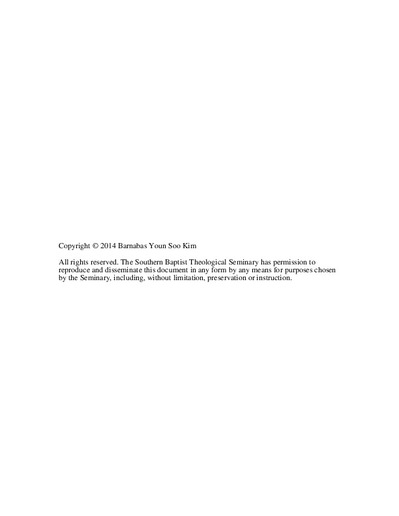| dc.description.abstract | ABSTRACT
THE USE OF IMAGINATION FOR EXPOSITORY
HERMENEUTICS AND HOMILETICS
Barnabas Youn Soo Kim, Ph.D.
The Southern Baptist Theological Seminary, 2014
Chair: Dr. Robert A. Vogel
The purpose of this dissertation is to discover the value of imagination for expository preaching. The thesis of this dissertation is that a rightly developed evangelical theory and use of imagination will improve the practice of expository hermeneutics and homiletics.
In the introductory chapter, the challenging nature of imagination is examined. Despite its subjective challenging nature, imagination is an important subject for expository preaching. Imagination is necessary in order to improve both hermeneutics and homiletics.
The second chapter provides an overview of expository preaching. Essential elements of expository preaching, author-centered hermeneutics and audience-focused homiletics, are discussed to form the backdrop against which imagination is to be examined. Second, the concept of imagination is introduced and explained.
Chapter 3 demonstrates how the New Homiletic methodology deals with imagination in preaching. After a brief introduction to the basic philosophy of the New Homiletic, the work of two new homileticians, Paul Scott Wilson and Thomas H. Troeger, is discussed. They are important, because they were one of the first to devote an entire work to imagination and preaching. This chapter concludes with a critical evaluation of their methods in light of evangelical expository preaching.
Chapter 4 presents suggestions for the use of imagination in expository hermeneutics. In particular, the role of imagination in specific steps of the exegetical process is explained. Furthermore, boundaries are discussed that ensure imagination is used in way that is faithful to the biblical text and the author's intention.
Chapter 5 suggests how imagination can be used in homiletics. Committed to a hermeneutic that is faithful to the text and the author's intention, preachers can find in imagination a rich resource to convey God's truth to people. | en_US |

